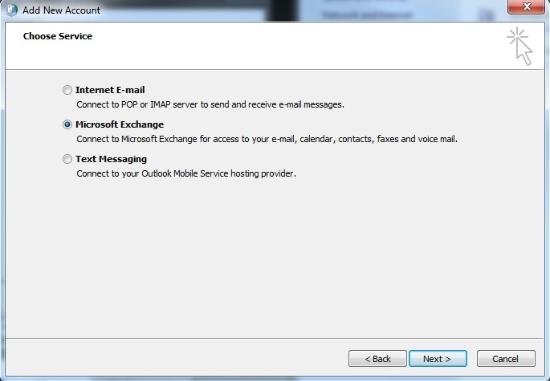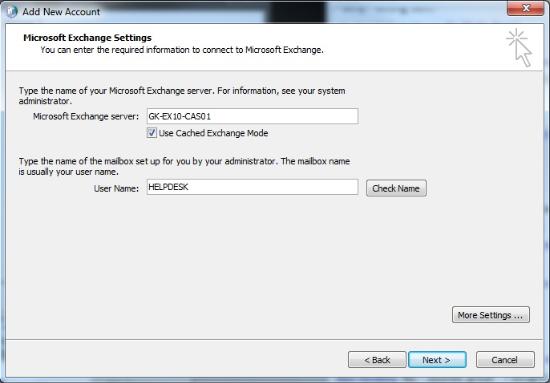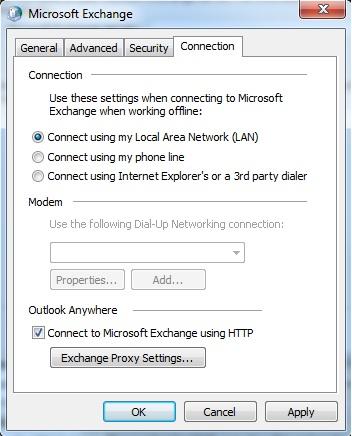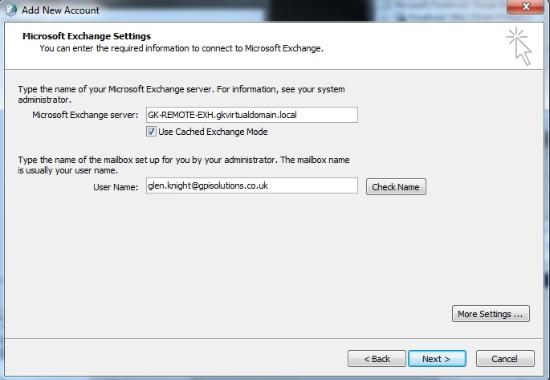Open multiple Exchange Servers mailboxes with Outlook 2010
TipsMake.com - As an IT consultant, you will have to access many mailboxes on different remote Exchange Servers.
In previous versions of Outlook, this means you will have to use different outlook profiles or use Outlook Web App (OWA) to make it harder to copy data between mailboxes or access the information. Details from all servers.
This is also true for those who work for 2 different companies and want to see information from 2 servers (work schedule, contact list, .).
However, in Outlook 2010 this is possible. Users can add up to 3 different mailboxes from different Exchange Servers. This is not the same as adding a secondary mailbox in the traditional way of using 'Open the additional mailboxes'.

Solution
Now, Microsoft has provided users with the ability to add extra Exchange accounts in Outlook 2010. This feature means that you can set up or 3 accounts directly connected to Exchange servers, 3 Exchange Servers. Different uses RPC-HTTPS or a combination of both.
Step 1 - Create a new Outlook Profile
We will have to create a new Outlook profile to describe it, but this step is like adding an extra mailbox to the profile in use.
We will install a standard Exchange Mailbox, then add an RPC-HTTPS mailbox from another Exchange. Use Outlook 2010 and Windows 7.
Click Start> Control Panel> User Accounts and select Mail , you'll see the Mail Setup - Outlook screen (below). Click the Show Profiles button.

On the next screen, click Add and give your profile a name. Then click OK . On the next screen select ' Manually Configure server settings or additional server types ' and then click Next .
Step 2 - Add Local Exchange account
Users will see the Choose Service screen. Select Microsoft Exchange and click Next .

Enter the name of the Exchange Server you want to connect to and the username of the mailbox you want to open (this is a locally configured mailbox - we'll do it later with RPC-HTTPS). Next, click Next . Do not click Finish quickly.

At the Congratulations ! There is an Add another account button . We can continue to configure RPC-HTTPS account by clicking this button. Again, choose Manually configure server settings or additional server types and click Next .
Step 3 - Add RPC-HTTPS account
In Choose Service select Microsoft Exchange and then click Next . In previous versions of Outlook, we could not do this because there was an Exchange account installed on this profile.
Before entering the Microsoft Exchange Settings information , click the More Settings button and select the Connection tab. In this tab, select Connect to Microsoft Exchange using HTTP and then click the Exchange Proxy Settings button.

On the Microsoft Exchange Proxy Settings screen (shown below), enter the URL used for Outlook anywhere for this peripheral mailbox. For many organizations, this is like Outlook Web App (OWA) URL but it may be different. So, it is better to check if you are unsure.

Besides, users also need to check Proxy authentication settings, depending on the Exchange server configuration is NTLM Authentication or basic . If when you complete the connection and you cannot fill in the confirmation information or you are always asked for confirmation, this setting may be wrong somewhere.
Click OK on the Exchange Proxy Settings screen and then click OK in the dialog box that opens later. Return to the Exchange Settings screen, enter the server name. This will be the server's real name (do not use the external URL here because it will not work) along with the user name or email address of the mailbox you want to connect to.

When you're done, click Next and Finish . Run Outlook 2010 using the profile you just created. This will give you access to both mailboxes in the same Outlook window. Besides, users can also drag and drop data between mailboxes as well as information about schedules.
When you create a new message, you can select the account to send the message to and place different signatures for each account.
You should read it
- Transfer mailboxes in Exchange 2007 through Exchange Management Console (Part 2)
- How to Back Up Exchange 2003
- Transfer Exchange 2003 to Exchange 2007 (Part 3)
- Discover EMC in Exchange Server 2010 (Part 1)
- Clean folders and emails on Outlook 2010
- All problems with PST, Profile, Add-in ... errors on Outlook and how to fix them
- Managing mailboxes in Exchange Server 2007 (Part 2)
- 4 ways to manage email effectively
May be interested
- Tips or troubleshooting connection problems on Outlook
 microsoft outlook sometimes has problems or errors connecting to the exchange server. handling this problem sometimes uses a simple way such as closing outlook and restarting. however, in some cases, it will be more difficult. the tips presented below will help you troubleshoot connectivity problems on outlook.
microsoft outlook sometimes has problems or errors connecting to the exchange server. handling this problem sometimes uses a simple way such as closing outlook and restarting. however, in some cases, it will be more difficult. the tips presented below will help you troubleshoot connectivity problems on outlook. - Configure Outlook 2007 with Exchange Server 2007
 in this article, we will show you how to configure outlook 2007 with exchange server 2007. we will also discuss how to work with the new exchange 2007 autodiscovery service with outlook 2007 and some new features in outlook 2007 as oof -
in this article, we will show you how to configure outlook 2007 with exchange server 2007. we will also discuss how to work with the new exchange 2007 autodiscovery service with outlook 2007 and some new features in outlook 2007 as oof - - How to fix the error of not being able to open Outlook, Outlook crashes
 when using outlook, there may also be errors, outlook cannot be opened or outlook crashes, leading to difficulty sending emails on outlook. the article below will guide you to fix the error of not being able to open outlook, the error of outlook not responding.
when using outlook, there may also be errors, outlook cannot be opened or outlook crashes, leading to difficulty sending emails on outlook. the article below will guide you to fix the error of not being able to open outlook, the error of outlook not responding. - Instructions on how to use Outlook 2013 for new people
 many companies use outlook not only because of its email features, but also other features like scheduling, tasks and contacts. a company can connect outlook to an exchange server and people can share the same address book and calendar.
many companies use outlook not only because of its email features, but also other features like scheduling, tasks and contacts. a company can connect outlook to an exchange server and people can share the same address book and calendar. - How to add a shared mailbox in Outlook
 shared mailboxes in outlook make it easier for people to interact, view content, and share work together.
shared mailboxes in outlook make it easier for people to interact, view content, and share work together. - Microsoft Outlook acceleration tips
 one of the habits of outlook users is storing too many emails. although emails you don't use, don't open them, outlook still loads these emails. this is the reason why outlook is slow.
one of the habits of outlook users is storing too many emails. although emails you don't use, don't open them, outlook still loads these emails. this is the reason why outlook is slow. - Switch from Exchange 2000/2003 to Exchange Server 2007 (part 1)
 how is the conversion from exchange server 2000 or exchange server 2003 to exchange server 2007 done? you will have to move data from every available exchange server in the exchange organization to the new exchange 2007 servers after having them shut down.
how is the conversion from exchange server 2000 or exchange server 2003 to exchange server 2007 done? you will have to move data from every available exchange server in the exchange organization to the new exchange 2007 servers after having them shut down. - 4 ways to manage email effectively
 if your email inbox is out of control, you may have to reconsider the methods for organizing email and deleting the mailbox you used.
if your email inbox is out of control, you may have to reconsider the methods for organizing email and deleting the mailbox you used. - Exchange 2007 Availability Services
 the availability service in exchange 2007 is an important service in practice, it is responsible for collecting updates about the busy / free status of users, and allowing them to run over outlook. 2007 and exchange 2007. in the future
the availability service in exchange 2007 is an important service in practice, it is responsible for collecting updates about the busy / free status of users, and allowing them to run over outlook. 2007 and exchange 2007. in the future - Move mailboxes between IMAP servers with IMAP TOOLS
 imap tools is a collection of perl scripts, allowing you to do many different tasks with imap server as well as pop3. in the following article we will guide you to move mailboxes between imap servers using imap tools.
imap tools is a collection of perl scripts, allowing you to do many different tasks with imap server as well as pop3. in the following article we will guide you to move mailboxes between imap servers using imap tools.










 Some common problems with Exchange 2003 systems - Activesync and workarounds
Some common problems with Exchange 2003 systems - Activesync and workarounds Import PST file into Exchange 2010
Import PST file into Exchange 2010 Delete the old SMTP domain from the Exchange 2007 mailbox
Delete the old SMTP domain from the Exchange 2007 mailbox Transfer Windows 2003 system with Exchange to Small Business Server 2008
Transfer Windows 2003 system with Exchange to Small Business Server 2008 Limit Spam with the Sender Reputation in Exchange 2007
Limit Spam with the Sender Reputation in Exchange 2007 Move mailboxes between IMAP servers with IMAPcopy
Move mailboxes between IMAP servers with IMAPcopy